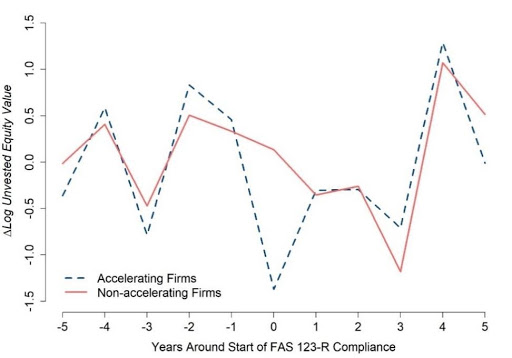Managerial Short-Termism and Investment: Evidence from Accelerated Option Vesting
Tomislav Ladika, Zacharias Sautner
Review of Finance, Volume 24, Issue 2, March 2020, Pages 305–344, https://doi.org/10.1093/rof/rfz012
Do managers sometimes boost short-term performance at the expense of long-run value? Financial analysts and policymakers frequently express concern about managerial short-termism. Business leaders like Jamie Dimon and Warren Buffet recently joined the fray, arguing that “companies frequently hold back on technology spending, hiring, and research and development to meet quarterly earnings forecasts.” (See “Short-Termism Is Harming the Economy”, Wall Street Journal, June 6, 2018.) Yet little clean evidence exists on the prevalence of managerial short-termism.
Our paper “Managerial Short-Termism and Investment: Evidence from Accelerated Option Vesting” helps to fill this gap. It provides new evidence that CEOs with more short-term incentives spend less on long-term investment. We start from the insight that CEOs’ incentive horizons are determined largely by the length of the vesting periods on their equity pay grants. Short vesting periods make it more likely that CEOs pump up the stock price and then quickly sell their shares at a profit. Investment cuts are a plausible target for myopic CEOs, because investors may only realize the long-term consequences years down the road. Therefore we examine whether CEOs reduce investment when vesting periods become shorter.
To examine this question, we exploit a unique event that led 723 firms to eliminate vesting periods on CEO stock options. FAS 123-R was adopted in 2004 and required firms to expense option compensation costs in their income statements. It created retroactive expenses for options granted years earlier that had not yet vested. Yet firms could avoid charges by accelerating options to fully vest before FAS 123-R’s compliance date. Option acceleration led to a 78% decline in CEO incentives from unvested equity – the single-biggest reduction in incentive horizon observed at these firms over a ten-year period (see figure).

Our analysis relies on almost-random variation in the timing of option acceleration. FAS 123-R took effect for each firm in the fiscal year starting after June 15, 2005. Therefore firms with “late” fiscal year-ends (June through December) complied before firms with “early” fiscal year-ends (January through May). Because of this staggered compliance schedule, late fiscal-year end firms were much more likely to accelerate options in 2005, while early fiscal year-end firms were more likely to accelerate in 2006 – even though the two sets of firms were otherwise highly similar. Our tests examine whether each set of firms was also more likely to cut investment in the year of acceleration.
We find that option acceleration led CEOs to cut both capital expenditures and R&D, leading to a $14m decline in total investment at the median accelerating firm. CEOs whose incentive horizons decreased more engaged in bigger cuts. Shortly afterward accelerating firms reported higher earnings, beat analysts’ forecasts at a higher rate, and experienced short-term stock price increases. Over the next year, their CEOs increased option exercises by 65%, and sold most of the resulting shares. Thus CEOs personally benefitted from stock price increases following investment cuts.